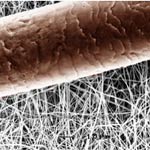

Idiomas:


Nanotechnology refers to the branch of science and engineering devoted to designing, producing, and using structures, devices, and systems by manipulating atoms and molecules at nanoscale, i.e. having one or more dimensions of the order of 100 nanometres (100 millionth of a millimetre) or less.
In the natural world, there are many examples of structures with one or more nanometre dimensions, and many technologies have incidentally involved such nanostructures for many years, but only recently has it been possible to do it intentionally.
Many of the applications of nanotechnology involve new materials that have very different properties and new effects compared to the same materials made at larger sizes. This is due to the very high surface to volume ratio of nanoparticles compared to larger particles, and to effects that appear at that small scale but are not observed at larger scales.
The applications of nanotechnology can be very beneficial and have the potential to make a significant impact on society. Nanotechnology has already been embraced by industrial sectors, such as the information and communications sectors, but is also used in food technology, energy technology, as well as in some medical products and medicines. Nanomaterials may also offer new opportunities for the reduction of environmental pollution.
But these new materials may also present new health risks. Humans have developed mechanisms of protection against various environmental agents of different sizes. However, until recently, they had never been exposed to synthetic nanoparticles and their specific characteristics. Therefore the normal human defence mechanisms associated with, for example, immune and inflammatory systems may well not be able to respond adequately to these nanoparticles. In addition, nanoparticles may also disperse and persist in the environment, and therefore have an impact on the environment.
As far as health risks are concerned, there are two types of nanostructure to consider:

This summary is free and ad-free, as is all of our content. You can help us remain free and independant as well as to develop new ways to communicate science by becoming a Patron!